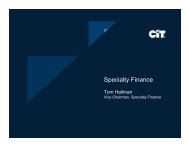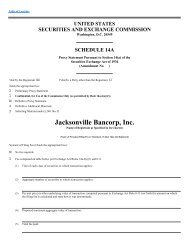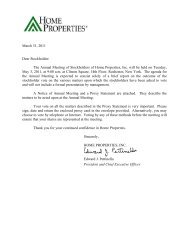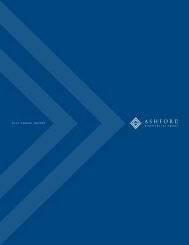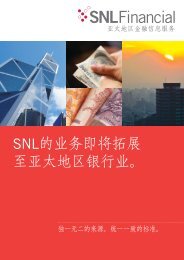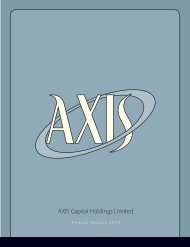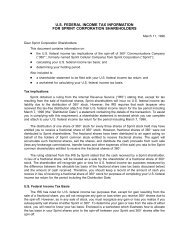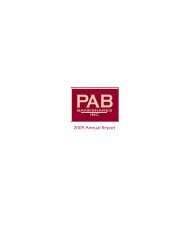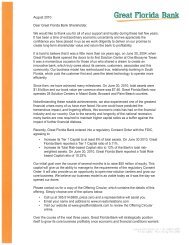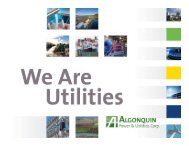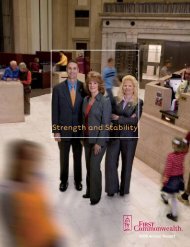Cousins Properties Incorporated 2006 Annual Report - SNL Financial
Cousins Properties Incorporated 2006 Annual Report - SNL Financial
Cousins Properties Incorporated 2006 Annual Report - SNL Financial
Create successful ePaper yourself
Turn your PDF publications into a flip-book with our unique Google optimized e-Paper software.
fair values at the date of acquisition in accordance with SFAS No. 141, “Accounting for Business Combinations.”<br />
The Company assesses fair value based on estimated cash flow projections that utilize appropriate discount and/or<br />
capitalization rates, as well as available market information. Estimates of future cash flows are based on a number of<br />
factors including the historical operating results, known and anticipated trends, and market and economic<br />
conditions. The values assigned to the tangible assets of an acquired property are based on the market values<br />
for land and tenant improvements and an analysis of the fair value of the building as if it were vacant. Intangible<br />
assets can consist of above or below market tenant and ground leases, customer relationships or the value of in-place<br />
leases. The values of the above and below market tenant and ground leases are recorded within Other Assets or<br />
Accounts Payable and Accrued Liabilities, in the Consolidated Balance Sheets. Above or below market tenant<br />
leases are amortized into rental revenues over the individual remaining lease terms, and above or below market<br />
ground leases are amortized into ground rent expense over the remaining term of the associated lease. The value<br />
associated with in-place leases is recorded in Other Assets and amortized to depreciation and amortization expense<br />
over the expected term (see Note 10 for further detail on Intangible Assets). On operating properties it has acquired<br />
to date, the Company has not recorded any value to customer relationships. Tangible assets acquired are depreciated<br />
using the methodology detailed below in the Depreciation and Amortization section.<br />
Depreciation and Amortization: Real estate assets are stated at the lower of fair value or depreciated cost.<br />
Buildings are depreciated over their estimated useful lives, which approximates 15-40 years depending upon a<br />
number of factors including whether the building was developed or acquired and the condition of the building upon<br />
acquisition. Furniture, fixtures and equipment are depreciated over their estimated useful lives of three to five years.<br />
Tenant improvements, leasing costs and leasehold improvements are amortized over the term of the applicable<br />
leases or the estimated useful life of the assets, whichever is shorter. Deferred expenses are amortized over the<br />
period of estimated benefit. The Company uses the straight-line method for all depreciation and amortization.<br />
Discontinued Operations: SFAS No. 144 also requires that assets and liabilities of held for sale properties be<br />
separately categorized on the Consolidated Balance Sheet in the period that they are deemed to be held for sale. The<br />
Company separately classified the cost basis of five ground leased outparcels in suburban Atlanta, Georgia, which<br />
were under contract for sale, to Property Held for Sale in the Consolidated Balance Sheet as of December 31, <strong>2006</strong>.<br />
The Company had no properties classified as held for sale at December 31, 2005. Also, in accordance with<br />
SFAS No. 144, the Company records gains and losses from the disposition of certain real estate assets and the<br />
related historical operating results in a separate section, Discontinued Operations, in the Consolidated Statements of<br />
Income for all periods presented. The Company considers operating properties sold or held for sale to be<br />
discontinued operations if the Company has no significant continuing involvement, as evaluated under EITF<br />
No. 03-13, “Applying the Conditions in Paragraph 42 of FASB Statement No. 144 in Determining Whether to<br />
<strong>Report</strong> Discontinued Operations.”<br />
Revenue Recognition<br />
COUSINS PROPERTIES INCORPORATED AND SUBSIDIARIES<br />
NOTES TO CONSOLIDATED FINANCIAL STATEMENTS — (Continued)<br />
Fee Income: Development and leasing fees are recognized when earned in accordance with Staff Accounting<br />
Bulletin (“SAB”) No. 101, “Revenue Recognition in <strong>Financial</strong> Statements.” Development and leasing fees received<br />
from unconsolidated joint ventures and related salaries and other direct costs incurred by the Company are<br />
recognized as income and expense based on the percentage of the joint venture which the Company does not own.<br />
Correspondingly, the Company adjusts Investment in Unconsolidated Joint Ventures when fees are paid to the<br />
Company by a joint venture in which the Company has an ownership interest.<br />
Under management agreements, the Company receives management fees, as well as expense reimbursements,<br />
which are comprised primarily of on-site personnel salaries and benefits, from third party property owners and joint<br />
venture properties, in which the Company has an ownership interest. The Company expenses salaries and other<br />
direct costs related to these management agreements. Management fees and expense reimbursements are recorded<br />
in Fee Income on the Consolidated Statements of Income in the same period as the related expenses are incurred, in<br />
accordance with EITF No. 99-19 “<strong>Report</strong>ing Revenue Gross as a Principal versus Net as an Agent” (“EITF 99-19”).<br />
F-9




